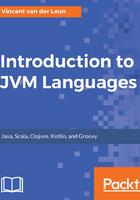
Java Class Library
For each edition of Java (more on available editions later in this chapter), it has been decided which classes are guaranteed to be available in a JVM implementation of a specific version. The Java Class Library for Java SE 8 is a very large collection of classes, and every JVM runtime installation that adheres to the Java SE 8 platform standard must implement those classes, regardless of the vendor of the JVM implementation.
Classes in this library provide functionalities such as writing or reading from the console window, performing file I/O, and communicating with TCP servers. Also, there are many classes available to start and manage operating system threads. More fundamentally, it contains classes that define data structures, such as lists and maps (called dictionaries in some other languages), among many others. In the next chapter, we will thoroughly look at the classes in the Java Class Library.
The Java Class Library is an important reason why language designers love targeting JVM. Using the data structures defined in the Java Class Library, they are able to focus more on the language design and less on building a full runtime library from scratch. Building a fully tested, multiplatform runtime system library comparable to the Java Class Library is a huge undertaking.